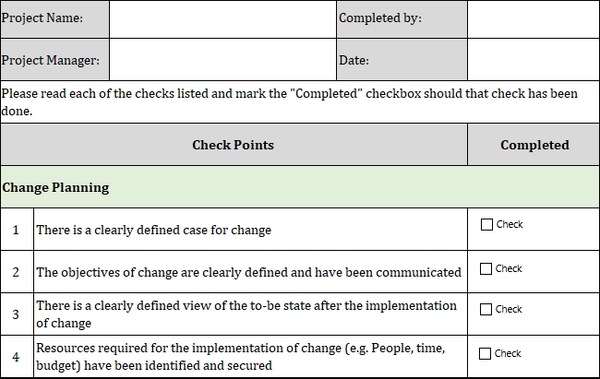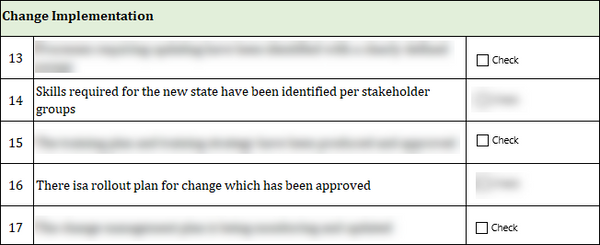ISO 27001:2022 Change Management Process Checklist Template
Any organization that is undergoing a significant transition must have an effective change management strategy. A well-defined template for change management can maximize success and minimize disruption, whether you are implementing new technologies, restructuring teams or adapting to changes in the market.Whether navigating shifts in processes, technology, or organizational structure, this tool ensures a systematic approach to planning, implementing, and communicating change. Streamline your change initiatives with this user-friendly checklist, promoting transparency, employee engagement, and overall success in the dynamic landscape of organizational transformation.
Why is Change Management important in Business?
Business success is dependent on change management, particularly in today's dynamic and fast-paced business environment. Change management is essential for many reasons.
- Minimizes resistance to changes: Resistance is often encountered during any transition in an organization, and this can be detrimental. Change management can help to overcome this resistance through involving stakeholders, communicating clearly, and addressing any concerns. Effectively managing resistance can help organizations increase acceptance and adoption.
- Employee engagement is maximized: Changes can be stressful for employees and lead to a decrease in morale and productivity. This encourages a more positive and engaged workplace, which leads to improved business outcomes.
- Accelerates implementation of change: Organizations can implement and execute change effectively when they use a structured process for change management. Change management is a guide for implementing changes, which includes timelines, steps, and responsibilities. A well-defined change management process can help organizations streamline their implementation, minimize disruptions and ensure a smooth transition.
- Improves customer satisfaction : Changes within an organization can have a significant impact on external stakeholders including customers. Effective change management includes assessing the impact of changes on customers, communicating the changes, and supporting customers throughout the transition.
Plan and Prepare for Change
The change management process is not complete without planning and preparing. This involves taking proactive measures to ensure that organizational transitions are well-planned and executed, with the goal of maximizing desired outcomes.Planning and preparing to change involves several key considerations.
- Conduct an extensive assessment: An exhaustive assessment is necessary to determine the current state of the organisation, identify areas that need improvement or changes, and assess the possible implications of a proposed change. This assessment should include an evaluation of both internal and external factors as well as stakeholder perspectives and possible risks and challenges.
- Identify key stakeholders : It is important to identify and engage all the relevant individuals and groups throughout the entire change process. Engaging stakeholders throughout the entire change process will help build buy-in and address concerns. It will also increase success.
- Develop a detailed plan for change management: A plan that is well defined outlines the timelines, responsibilities, and steps involved in implementing a change. It is important to identify key milestones and establish communication and decision-making channels. Plan for potential risks, contingencies and strategies to monitor and evaluate the change.
- Communication and engagement : These are essential for gaining support and buying-in from stakeholders, and managing expectations throughout the process of change. Communication must be transparent, timely, and tailored for different stakeholder groups. Engaging stakeholders in regular feedback mechanisms, through training programs and participation in the decision-making process, helps to foster ownership and commitment towards the change.
- Prepare for resistance : It is essential to prepare and deal with any potential resistance. By proactively addressing employee concerns, offering support and involving them in the process of change, organizations can reduce resistance and increase acceptance.
Checklist for Change Management
Here are some important considerations and steps to implement and communicate the change.
- Establish a timeline: Before implementing a change, it's important to create a timeline that clearly outlines milestones and activities to be completed. This timeline is a guide for the implementation and keeps everyone accountable.
- Assign responsibilities: Identify individuals or teams that are responsible for different aspects of change. To ensure that the implementation process is smooth, communicate their expectations and roles.
- Provide training and support : Changes can be met with resistance or even uncertainty. This is especially true if they involve new processes or technology. This training will help them to understand why the change is happening, how it impacts their role, and how they can adapt to new working methods.
- Monitor and deal with resistance: Even after thorough planning and preparations, there may be resistance to the change. Monitor for any signs of resistance from employees or stakeholders, and address concerns or misconceptions as soon as they arise. Early resistance can improve the likelihood of a successful implementation.
- Evaluate, and adapt : Throughout the process of implementation, it is essential to evaluate the success of the changes and make any necessary modifications or adaptations. Gather feedback from all stakeholders to help inform future decisions and improvements.
- Celebrate your successes : As you achieve milestones and see positive results, celebrate them and thank all those involved. Recognize their contributions and reward them for the successful implementation. This will not only increase morale and motivate employees, but it will also reinforce the importance of change.
Evaluation and Monitoring of Change
In the process of change management, it is important to evaluate and monitor the changes. It allows the organization to evaluate the effectiveness of implemented changes and make necessary adjustments or improvements.
Organizations can identify and address potential problems or areas of improvement by regularly evaluating and tracking the change. These are the key steps and considerations involved in evaluating and tracking change.
- Define evaluation metric: It is important to establish clear metrics to be used in evaluating the success of a change. These metrics must align with the goals of the change. They can include factors like increased productivity, customer satisfaction, cost reductions, or other relevant indicators.
- Analyze data: Once the data has been collected, it must be analyzed in order to gain meaningful insights. This analysis will involve comparing data to the defined metrics, and evaluating whether the desired outcomes have been achieved. This can include identifying trends, patterns or areas that need further investigation.
- Identify areas of improvement and gaps: Organizations can use the analysis to identify areas that need improvement or gaps in the implementation of the change. By identifying the gaps, organizations are able to take proactive measures and improve the effectiveness of change.
- Communication of findings and recommendations : Once the evaluation has been completed, it is essential to communicate findings and suggestions to all parties involved in the process. By involving stakeholders in evaluation processes and providing the information they need, organizations can encourage a sense ownership and engagement with the change initiative.
- Make improvements and adjustments: Organizations should make the necessary improvements or adjustments to the change based on the findings and recommendations of the evaluation. These adjustments should be approached with a mindset of continuous improvement and proactive thinking.
- Monitor the change continuously: Monitoring and evaluation should continue throughout the implementation of the change. This monitoring is essential for organizations to be able to adapt to new circumstances, identify new issues, and ensure that the change will last.
Conclusion
In conclusion, the Change Management Process Checklist emerges as a fundamental companion in the complex terrain of organizational transformation. By providing a structured roadmap encompassing planning, implementation, and communication aspects, this checklist becomes an invaluable tool for navigating change seamlessly. As organizations strive for agility and resilience, embracing this checklist fosters a culture of preparedness and adaptability. From fostering employee engagement to ensuring transparent communication, this checklist empowers teams to proactively manage change, ultimately contributing to the successful evolution of the organization. Utilize this resource to not only streamline change initiatives but to also foster a positive and proactive approach towards embracing the ever-evolving nature of today's business landscape.





